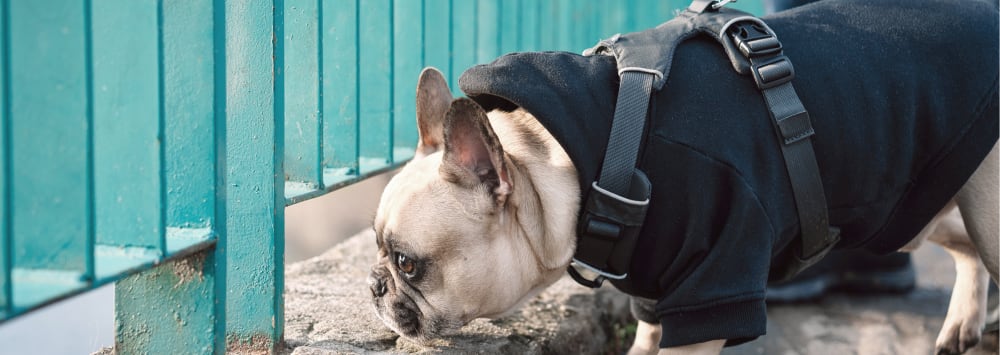
Intervertebral disc disease (IVDD), is a serious spinal condition that can occur in dogs that often requires surgery to correct. Today, our Clovis vets discuss IVDD in dogs and how it is treated.
What is IVDD in Dogs?
In between the bones of the spine are intervertebral discs. They are made of cartilage and surrounded by a ring of harder, fibrous tissue. They act as cushions to the bones in the spine, helping absorb the impact caused by running and jumping.
There are two types of intervertebral disc disease (IVDD):
Type 1
The first type of IVDD can be referred to as a "slipped disc." It occurs when the middle, gelatinous, part of the disc becomes calcified and then ruptures through the outer part of the disc. Although the calcification of the cartilage can happen slowly over time, the rupture itself is acute and generally occurs as a result of forceful impact (jumping, landing, etc.). Type 1 IVDD generally occurs in small-breed dogs but can occur in some large-breed dogs such as Labrador retrievers, German Shepherds, dalmatians, Rottweilers, and pit bulls. This type of disc herniation occurs most commonly in young- to middle-aged dogs.
Type 2
The second type of IVDD typically affects middle-to-older aged large-breed dogs. It is caused by chronic bulging of the outer part of the disc on the spinal cord. The condition is typically slowly progressive and may or may not be painful. The chronic spinal cord compression associated with this type of disc disease often causes atrophy of the spinal cord.
While a disc can bulge or herniate anywhere along the spinal column, 65% of accounted disc ruptures occur in the thoracolumbar (midback) area, while 18% occur in the cervical (neck) region.
What are the symptoms of IVDD?
Common symptoms of IVDD include:
- Pain in the neck or back region
- Unable to fully lift head
- Unwilling or unable to walk
- Difficulty urinating and defecating
- Difficulty breathing
- Shaking or trembling (a sign of pet being in pain)
- Knuckling on paws
Diagnosis of IVDD
You should bring your dog to the vet if you notice any of the symptoms listed above. If your dog is experiencing severe symptoms such as a complete inability to walk and trouble breathing, they should be brought to an emergency veterinary clinic immediately.
When you bring your dog in for an exam, your vet will perform a thorough physical exam, including a neurological exam to locate the area of the spinal cord that is affected. Your vet will also use diagnostic imaging tools, such as X-rays or an MRI, to get a better look at your pup's spine.
Once the severity of the IVDD is determined, your pet will either begin conservative treatment or be recommended for surgical intervention.
Owners should be aware that these breeds of dog are predisposed to IVDD:
- Dachshund
- Shih Tzu
- Beagle
- French bulldog
- Pekingese
- Lhasa Apso
- Corgi
- Basset hound
- Poodle
- Chihuahua
- Cocker spaniel
- Labrador retriever
- German shepherd
- Doberman pinscher
Can a dog recover from IVDD without surgery?
If the disease is in its early stages and the neurological symptoms are mild, your veterinarian may recommend conservative treatment in the form of pain medication, crate rest, weight management, or physical therapy. Many of these patients may require surgery down the road.
Patients who undergo IVDD surgery will have the bone overlying the spinal cord, and the disc material compressing the spinal cord, removed. This will be followed by several days of hospitalization, pain management, physical therapy, and possible bladder management.
Prognosis
The prognosis of IVDD can vary depending on how significant the condition is when it is diagnosed and treated. IVDD surgery success rates are around 90% when a dog is in the early stages of the disease. In dogs who have severe or progressed IVDD, the success rate of surgery in restoring leg function is about 50-60% if surgery occurs within 24 hours of the acute disc herniation. The success rate drops significantly lower if more than 24 hours have progressed since the ruptured disc.

